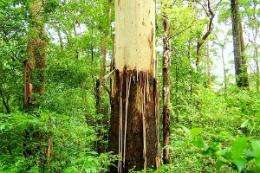Native species proposed as viable long-term sequesters

(PhysOrg.com) -- New research into the carbon sequestration abilities of native tree species was undertaken by Greening Australia, and will hopefully make native species more attractive and viable option for carbon farming.
Prior to the study there had been little research into the levels of carbon which local non-timber species of trees are able to sequester carbon, and most large scale reforestations used non-native species of trees.
Greening Australia’s Justin Jonson who co-authored the paper says the use of a single species for large scale land-use change does not offer the best long-term outcomes and focus on more than just carbon sequestration.
He says monocultural reforestation for carbon capturing does not provide the secondary benefits that the use of native species is able to achieve.
The use of native species to create a more natural woodland system will provide a habitat that can support local fauna and provide a range of benefits to biodiversity.
Mr Jonson says native species can also provide evidence of permanence which is untested in monoculture carbon farming.
Under Australia’s Carbon Farming Initiative carbon stores must be held for at least 100 years to meet the standards set.
If the carbon is released back into the atmosphere before this time there are no benefits gained.
“The carbon pools have to be a permanent entity, they have to be able to stand climactic and environmental conditions for up to 100 years.” Jonson says.
“What is untested in these monoculture style plantations of high growth species... is that there are no plantings that go back even 50 years.”
“The only thing we have certainty on, that we know can persist for more than 100 years are the natural systems that have persisted for many hundreds of years and that is why they endure.”
Mr. Jonson says there is a responsibility by the industry and the government to think long-term about any reforestation initiatives.
“You need to think about future generations when you are talking about permanent land use change,” he says.
“Whatever we put in at the beginning we are stuck with.”
The study—based in the area between the Stirling Ranges and the Fitzgerald River National Parks north-east of Albany—filled a knowledge gap on the level of carbon native species sequesters.
The area is part of a large conservation initiative called the Gondwana Link which is trying to reconnect the remaining fragmented native bushland in the South of Western Australia.
Provided by ScienceNetwork Western Australia




















